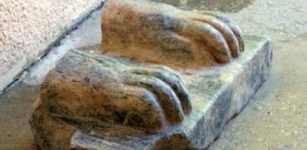Mystery Of Gigantic Lion Sculptures Dated To The Hittite Era
MessageToEagle.com – Archaeologists have been working to solve the mystery of five-ton lion sculptures recently found in a field in Sorgun, a town located in the Central Anatolia, Turkey.
A preliminary investigation has been made in the area and it shows that a field served as a sculpture atelier in the Hittite era.

“It is not exactly known why these lion sculptures were created. It is estimated that they were made between 1,400 and 1,200 B.C. during the era when the Hittites ruled Anatolia,” Yeniyer Mayor Osman Yilmaz said to Hurriyet Daily News.
“The top part of their head is a bit higher than their neck. It is thought that these sculptures were dedicated to a holy water source.”

The top part of their head is a bit higher than their neck. It is thought that these sculptures were dedicated to
a holy water source.” Credits: DHA photo
Large rocks in a stone pit, the biggest of which is in two-meter diameter, have also been found in the field, further complicating the mystery. Regarding the sculpture’s possible purpose, Yılmaz said that research done around Karakız [a Yeniyer neighborhood] indicates that the region was a Hittite settlement when these sculptures were created.
See also:
Magnificent Hattusha: Capital Of The Hittites
Yazilikaya: One Of The Most Striking Religious Shrines Of The Hittite Empire
“Due to the gigantic size of the lions, it was not much possible to make them in another place and move them here,” Yılmaz explained.
In this particular region of the Central Anatolia, archaeologists have already unearthed a large number of important archaeological artifacts.

The first artifacts were found in 1982 by the Yozgat Museum Directorate. In 1987, the Hapis Boğazı ruins were put under protection. The museum directorate registered this field in 2009 as the Karakız Sculpture Atelier.”
Unfortunately, due to lack of sufficient protection, treasure hunters had already damaged the ancient artifacts.
Yılmaz said experts had organized the first Hapis Boğazı Hittite Sculpture Atelier Festival last year and they would organize the second edition this year.
“We organized an event last year in Karakız and Hapis Boğazı to contribute to the promotion of the Hittite Sculpture Atelier. We set to organize the second festival this year on July 9 and 10. We believe such events will promote the region,” he said.
MessageToEagle.com
Expand for references









